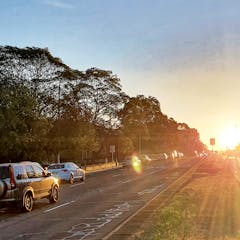
Articles sur Urban design
Affichage de 21 à 40 de 190 articles

For a long time the roof has been an afterthought in urban design, but the future is definitely looking up.

If you’re stuck in mall traffic this holiday season, spare a thought for Victor Gruen, whose grand urban vision turned into today’s suburban reality.

In cities across Europe, 62% of the population doesn’t have access to the amount of nature the World Health Organisation recommends.

City centres have been hit hard by lockdown measures - but can artists and entrepreneurs really breathe life into the space?

99% of people below the floors where the planes struck the twin towers evacuated successfully, although their journey was fraught with danger. Their stories have influenced today’s skyscraper designs.

The research, focused on the Jordan Springs estate in Western Sydney, found houses were built close together and made from materials which exacerbate hot weather.

Generic urban landscape design is damaging for people and nature: an ecomimicry approach instead encourages nature to flourish even in cities.

Smart street furniture can do a lot of things at once. Some of these functions offer the public clear benefits, but the data collection and surveillance capabilities raise a number of concerns.

When Buffalo, New York, changed its zoning code so that developers no longer had to provide specified amounts of parking, space was freed up for public transit and people.

The gaybourhood gave LGBTQ+ communities the space they urgently needed to simply be themselves. But our cities should be built in such a way that everyone feels at home

The utopian 20th-century model of a modern city – one that has been replicated around the world – is being exposed as unsuitable for adapting to the pace of change in the 21st century.

Roadsides have long been reserved for parking cars, but the pandemic led to many experiments with other ways of using scarce and valuable public space. We can put it to better and more flexible uses.

NSW is developing a comprehensive new planning policy with the goal of creating healthy places. A new study finds those people who work as placemakers want these goals embedded in laws and budgets.

The earth our towns and cities are built on is teeming with potential. It is under threat too

Performances could return sooner than planned if cities are ready to adapt.

Our buildings and cities were not designed to handle a pandemic. But countries around the world are coming up with design ideas, some high-tech and some more basic, to reduce the infection risks.

As our cities get hotter, rebuilding whole suburbs better suited to the heat is not an option. Instead, we can draw from the best examples of how to adapt neighbourhoods and behaviours.

A study of preschoolers’ understanding of their urban environments suggests their voices should be heard more in city planning.

Valuing children’s views could lead to better urban space for everyone.

Proposals to improve the capital’s urban design and density must also take account of the city’s unique streetscapes.
